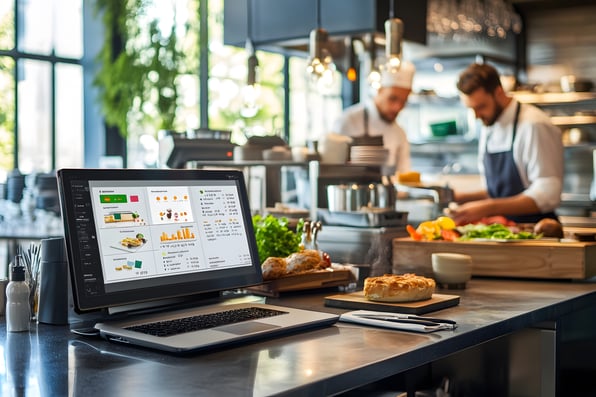5 Best Practices For Assisted Living Menu Planning

Meals are among the most significant factors impacting resident satisfaction in senior living communities. A rotating selection of delicious and healthy foods keeps residents happy and eager to order their next meal. On the other hand, residents who get served the same bland meals month after month quickly become bored and frustrated. They may even start shopping for a new community that can provide the quality dining experiences they expect.
Senior dining professionals can use assisted living menu planning to improve the resident experience and prevent boredom. This approach involves strategically creating rotating menus with various nutritious and tasty meal options.
Menu planning takes time and effort, but has many benefits for residents and staff. This guide covers five best practices to help communities get started and increase efficiency during meal planning.
Master Assisted Living Menu Planning: Best Practices
Many senior living communities keep the same menus for years and resist changing. They may assume frequent menu swaps will confuse residents or create too much work for staff. Worse, they might be afraid that residents will order new meals that contain allergens or don’t fit their dietary needs.
These concerns are valid. Luckily, though, new assisted living technology makes it easy for communities to avoid issues and reap the rewards of meal planning.
Here are five ways dining professionals can use meal planning software and other tools to diversify assisted living menus.
1. Resident-Centered Approach
Successful menu planning prioritizes the needs and desires of residents. After all, these folks will need to eat the food multiple times a day.
Communities can adopt a resident-centered approach by:
- Seeking Input: Regularly gather input from residents about their dining experiences and preferences. Dining staff can conduct individual resident interviews, pass out comment cards, and ask residents to vote on monthly menu themes.
- Offering Customization: Give residents more control over their dining options by allowing them to customize their meals. Software like eMenuCHOICE enables users to swap ingredients, specify how they want their food cooked, and more. For instance, a vegetable-loving resident can ask the chef to add extra carrots to their soup and substitute their bread for a side salad.
- Analyzing Resident Demographics: Communities can use integrated software like eMenuCHOICE to gather resident data from electronic health records and identify trends. Say a senior community has a large population of residents with heart conditions. They can use this information to develop menu items for cardiac diets.
2. Collaboration With Culinary Experts for Dietary Requirements
Assisted living residents often have complex nutritional needs. Dining services staff can partner with culinary experts and nutritionists to ensure they provide a balanced menu.
eMenuCHOICE simplifies this process by providing nutritious menus and recipes designed by Passion for Dining and Nutrition. This service specializes in creating delicious, dietitian-approved meals for senior living residents. Communities can use these recipes to speed up meal planning and provide a variety of options.
3. Seasonal and Local Ingredients
Incorporating seasonal ingredients is one of the most effective ways to provide a steady stream of fresh and flavorful menu options. Communities can adapt their menus each month or season to take advantage of local produce.
For example, a June menu might include dishes filled with fresh summer vegetables and fruits, such as:
- Salads packed with locally-grown spinach, peppers, and corn
- Melon slices
- Berry parfait
- Grilled asparagus
- Tomato basil pasta
- Raspberry tart
- Cucumber mint lemonade
An October menu could focus on comfort foods made with autumnal ingredients, including:
- Kale salad
- Roasted carrots, brussels sprouts, and sweet potatoes
- Apple and walnut salad
- Stuffed acorn squash
- Pumpkin pie
- Pumpkin spice latte
Seasonal fruits and vegetables are rich sources of essential vitamins, minerals, and antioxidants. Designing menus around these ingredients allows communities to offer a healthy diet.
eMenuCHOICE offers rotating, four-week menus centered on seasonal ingredients so communities can provide new dining choices throughout the year. This variation keeps residents mentally enriched and prevents daily meals from becoming stale or predictable.
4. Automatically Updated Healthy Menus
Senior living communities have traditionally relied on old-fashioned paper menus and whiteboards to share meal options. However, manually updating these menus can be time-consuming and wasteful. Most especially for communities that make frequent menu changes.
Staff may print and throw away thousands of paper menus each month. And residents may feel disappointed if they accidentally try to order discontinued menu items from an outdated version.
Assisted living technology like eMenuCHOICE reduces waste and improves resident satisfaction by providing automatically updated digital menus. Residents can view these menus from self-service kiosks, smartphones, tablets, and other devices.
These digital menus can:
- Track inventory and automatically remove out-of-stock menu items
- Provide detailed menu descriptions of new menu items so residents understand what they’re ordering
- Automatically substitute allergens for new ingredients
Electronic menus with automatic updates also save staff time. Instead of dashing to the kitchen to check if the chef is still making the daily soup, dining professionals can instantly consult the menu for the latest information.
5. Regular Menu Plans and Updates With the Right Tool
Developing new assisted living menus is both an art and a science. Dining professionals must understand their residents’ likes and dislikes, cultural backgrounds, and special dietary restrictions. At the same time, they need to ensure that their menus provide balanced meals that support residents’ well-being.
A meal planning service like eMenuCHOICE streamlines and optimizes this process. The technology provides many benefits for senior living communities, including:
- Pre-designed menus and recipes
- Automatic menu updates
- Weekly ingredient ordering guides
- Automatic ingredient substitution based on allergies and dietary preferences
- Faster meal ordering
- Inventory management
- Easily accessible electronic menus
- Personal resident profiles
Empower Resident Choices and Involvement With AL Technology
Menu planning allows communities to enrich the resident dining experience and provide diverse meals. This process might sound complicated, but following these five best practices can simplify meal planning.
eMenuCHOICE makes it easy for senior communities to implement these tips. The software provides nutritious menus and recipes suitable for various dietary approaches. That way, staff won’t have to spend hours searching for the perfect vegan or kosher recipes. eMenuCHOICE also offers numerous convenient features to increase resident satisfaction, including customized menu items and meal delivery options.
Get in touch today to schedule a free demonstration and learn more about how eMenuCHOICE can make menu planning more efficient, healthy, and satisfying.



